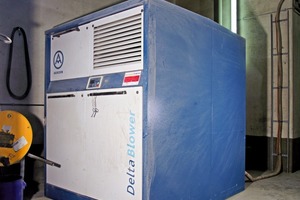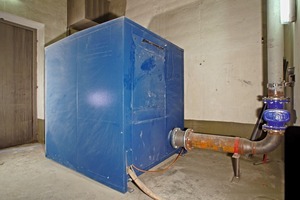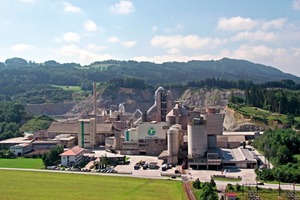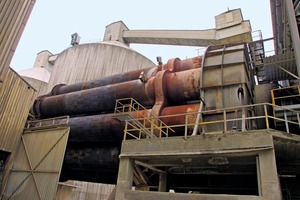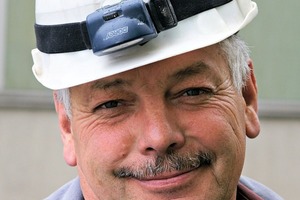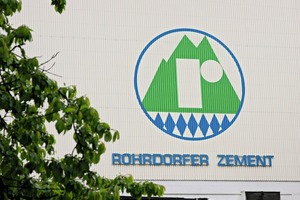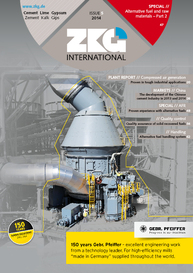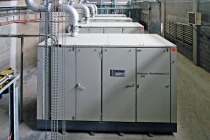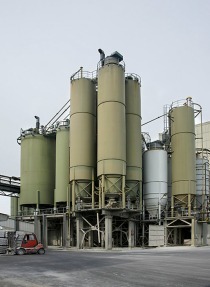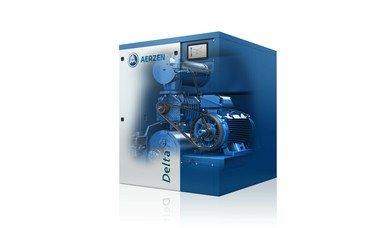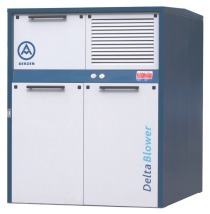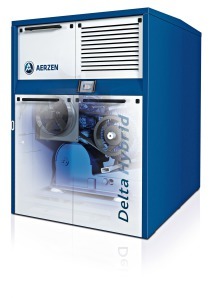Proven in tough industrial applications
The production of oil-free compressed air with a maximum pressure of between 1.0 and 1.5 bar was previously a tricky subject because it was not possible to achieve such high pressures with blowers. The use of screw compressors as an alternative was a cost-intensive solution for this pressure range, because this type of compressor is designed and constructed for higher pressures of 2.0 or 3.5 bar. For this reason, the technically complex oil-free production of compressed air with a screw compressor system involves higher capital expenditure.
Now, the Aerzener Maschinenfabrik has marketed the long-awaited solution: the new Delta Hybrid compressor series (Fig. 1 and 2). In a ground-breaking symbiosis, this new series combines the advantages of blower and compressor systems into a unique concept. These rotary piston compressors deliver volume flows of 10 to 70 m3/min and cover a pressure range of -0.7 to 1.5 bar. Meanwhile, the Delta Hybrid compressors have proven their effectiveness in numerous multi-year tests under rugged conditions in widely differing industrial sectors, including the Rohrdorf cement factory (Fig. 3) near Rosenheim in Southern Bavaria/Germany.
The Rohrdorf factory has an annual production output of 1 million t of cement. From the raw materials to the cement product, the production process involves many stages where the use of compressed air plays a crucial role. Firstly, the limestone and marl rock is comminuted in a crusher. The resultant crushed rock is then buffer-stored as separate material components and then fed as a defined mixture to the raw mill, dried with kiln exhaust gas, ground to powder and again stored in silos. Subsequently, the raw meal is conveyed with the assistance of compressed air to the preheater and the rotary kiln, which burns clinker at a rate of 3500 tpd. This production process runs non-stop for ten months of the year. Only in winter does the plant take a two-month “break” to allow the required maintenance and conversion work to be carried out.
The “core machine” of this multi-stage production process is the already-mentioned rotary kiln (Fig. 4). The kiln system initially heats up the raw meal to around 1000 °C and subsequently burns it at a temperature of approximately 2000 °C. One of the fuels used for firing the kiln burner is pulverized coal. At the Rohrdorf cement factory, the pulverized coal is stored in two parallel silo installations and then pneumatically conveyed to the rotary kiln in separate piping systems. There is a regular usage changeover between these parallel storage and conveyance systems.
The pulverized coal is discharged from the silo system via a filter, dosing weigher and supply pump to the assigned piping system and is then pneumatically conveyed to the rotary kiln by compressed air with a constant pressure of 1.5 bar via a delivery pipe with a length of approx. 65 m. At the kiln, the coal is injected via a nozzle. Approximately 75 t of pulverized coal is conveyed to the kiln every day. Until two years ago, the required system pressure was produced by a screw compressor in each conveying pipeline. A third compressor unit served as stand-by. In the case of malfunctions, it could be connected via a pipe diverter to the conveying pipeline with the faulty compressor. All three air-cooled units work in a central conveying air station and are operated via the central control system. Evaluations of the plant data are transmitted by Profi-Bus for display on monitor screens and for printing out.
Since 2008, the central conveying air station of the Rohrdorf cement factory has been equipped with a rotary piston compressor of the new Delta Hybrid series from Aerzener Maschinenfabrik, in addition to the three screw compressors. The Delta Hybrid unit (Fig. 1) delivers 43.9 m3/min of compressed air with a maximum pressure of 1.5 bar. The screw-type compressor that was originally active in this conveying pipeline was shut down after the new Delta Hybrid unit was installed, because the amount of conveying air required for conveying the pulverized coal in this supply pipe could then be delivered by the new Delta Hybrid unit on its own.
Due to the monthly change-over between the two silo/conveying systems, this compressor works against pressure load non-stop around the clock for four weeks after its conveying pipeline is activated. After that operating period, the system is switched over to the second conveying pipeline and its compressor. On this basis, the new Delta Hybrid unit has so far operated for twelve four-week working periods since it was put into service in 2008. Each of those working periods involved almost 700 hours of permanent operation against pressure load. This means that the installed Delta Hybrid compressor has reached a total of approx. 8000 operating hours.
In a cement factory, Aerzener compressor units have to work under what are predominantly very extreme conditions, due to the dusty ambient air. These working conditions explain why only especially robust equipment survives in the cement industry. These extremely high demands were also placed on the conveying air compressor of the new Delta Hybrid series. Since it was put into service two years ago it has achieved an outstanding performance despite the adverse environmental conditions.
Peter Reiter (Fig. 5), manager of the mechanical maintenance department in Rohrdorf, confirms from his extensive experience in the industry that Aerzener Maschinenfabrik selected the right design concept for the new Delta Hybrid compressor: “For conveying the pulverized coal, we need compressed air with a maximum pressure of 1.5 bar. Owing to the lack of suitable alternatives, we previously had to use screw compressors, despite the fact that they involve significantly higher purchase costs than blowers.”
For this reason, the company was very glad when the new Delta Hybrid series came on the market, because it amalgamates the advantages of a blower with those of a screw compressor.
With the use of conventional rotary blowers, it was previously only possible to produce pressures up to a maximum of 1 bar. For pressures above that figure it was necessary to use screw compressors, even though their single-stage design was intended for significantly higher pressures of 2 and 3.5 bar. This design of compressor is therefore “much too good” for very low pressures, and is therefore also too expensive for such applications. This is where Aerzener successfully applied its design expertise. The company has been building rotary blowers since 1868 and screw compressors since 1943.
The new Delta Hybrid units for oil-free compression are a symbiosis of both systems, ideally combining their respective specific advantages. For low pressures, the units function more like a blower, while for higher pressures they function more like a screw compressor. Their intended area of application is the conveyance of materials in air or neutral gases at a pressure of up to 1.5 bar; for instance in sewage treatment plants, in the chemical industry, in power stations or for transporting and unloading pulverulent materials.
The new rotary piston compressor series successfully passed a large-scale field trial carried out over the last three years in a number of different industrial sectors under the most severe operating conditions, and has been developed to market maturity. All the field-tested units were continuously monitored to the last detail using the Aerzener RAT remote monitoring system.
The compressor unit that was put into service at the Rohrdorf cement factory two years ago delivers a constant 43.9 m3/min of compressed air with a maximum pressure of 1.5 bar under difficult ambient conditions. According to Peter Reiter, the knowledge collected so far indicates that its electrical energy consumption is 5 to 8 % lower than that of a comparable screw compressor – and that despite the overdimensioning of the unit. It is above all the argument “low energy expenses” that is of central significance for the overall cost balance of a blower or compressor. In a multi-year analysis, the energy expenses alone are responsible for around 90 % of the total costs of a plant and only the remaining 10 % is accounted for by capital expenditure and maintenance costs.
The new Delta Hybrid units are available in the following performance ranges:
Volume flows:
10 to 70 m3/min (600 to 4200 m3/h)
Applications:
for air overpressure and negative pressure
Pressure range:
0 to 1.5 bar
Suction range:
up to 0.7 bar negative pressure
Further characteristics are:
A particularly favourable cost/performance ratio, with significantly lower overall costs than the capital expenditure, energy and maintenance costs for a comparable turbo compressor or screw-type compressor
A significantly improved energy efficiency, with consumption figures 15 % below those of conventional units
Low maintenance and servicing costs; high reliability and long service life
A robust bearing construction (service life 60 000 h, even at maximum loading)
Low compressed air outlet temperatures, thanks to a thermally compact design
A very high control range (25-100 %)
Belt drive (belt tensioning by motor rocker)
Side-by-side installation (even in outside areas)
Front-panel operation
Oil checking and topping up without interrupting operation
Low noise level
Optional control system: AS300 AERtronic
Simple operation and maintenance
If a smaller motor is installed, thereby reducing the delivery volume, the electrical power requirement could be lowered even further. Currently, the Rohrdorf unit is equipped with a 110-kW motor, but the operator’s latest calculations indicate that a 55-kW motor would be completely adequate. The unit would only have to be equipped with a lower-power drive motor and a different V-belt transmission. It would not be necessary to change the compressor stage. Thanks to the V-belt drive concept, changing the drive motor of a Delta Hybrid compressor is totally unproblematic. A compressor with direct coupling would make this kind of subsequent performance modification completely impossible.
“We are redesigning our piping system to reduce the conveying distance,” Peter Reiter told us. “This will lower the conveying air requirement still further. By again reducing the compressor’s drive power, we will be able to optimally adapt the Delta Hybrid unit to the new requirements and run our air compressor system with the highest possible cost effectiveness in every operating situation, he emphasized.
//www.aerzener.de" target="_blank" >www.aerzener.de:www.aerzener.de

